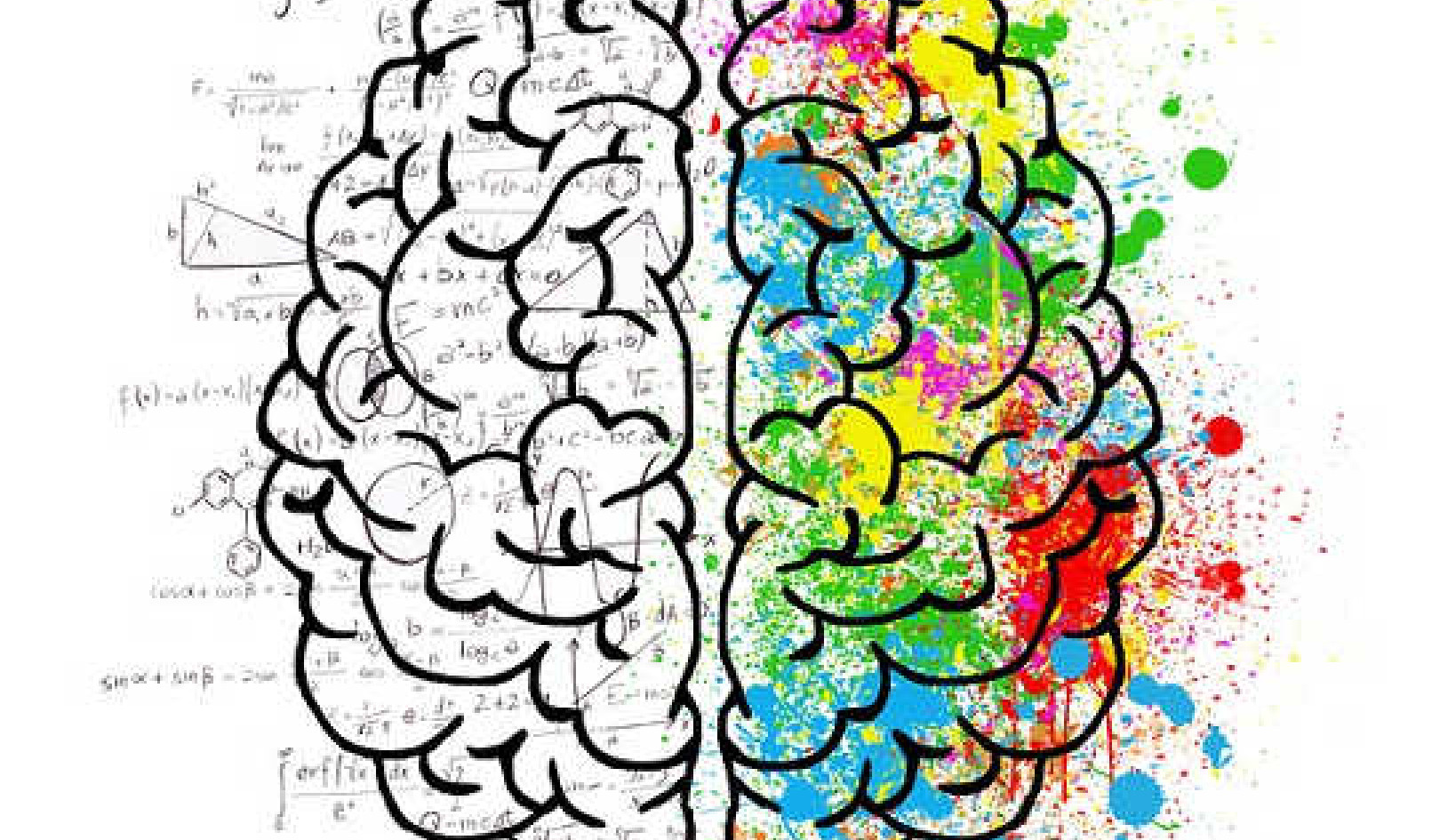
I have a tiny suspicion that someday, far in the future, people will look back at our ideas about the right brain-left brain dichotomy and laugh. I suspect they will find this brain theory of ours ridiculously primitive and they will wonder at our lack of understanding, in much the same way that today we cringe at outdated medieval medical practices.
But for the time being, the right brain—left brain model is the best understanding that we have. For those not familiar with it, let me give you the most basic outline. Different parts of the brain appear to be in charge of different functions. The left hemisphere is thought to be responsible for logic, language, and analytical, step-by-step thinking. The right hemisphere is thought to be responsible for intuition, visual design, and holistic, big-picture thinking.
Of course, no one is only right- or left-brained. But you may recognize yourself dwelling more in one camp than in the other. And you may be slightly relieved to know that your tendency to process information verbally (causing your mother to describe you as a chatterbox) or your tendency to get caught up in the flow of something and lose track of time is not disobedience on your part but rather a function of how your brain works.
Many artists find themselves heavily favoring their right brain, but even so, artistic blocks caused by left-brain intervention occur even to the best of us. So there you are, trying to let your ideas blossom while your left brain is standing there tapping its foot and saying, "This old dumb thing again? Didn't you do this already? Aren't you done yet?" And so forth. And, you know, that voice sounds so darned logical.
But the fact of the matter is that right now you're trying to get some work done and you're stuck. The trick is to give your logical, linear, left brain something interesting to do while your right brain gets to do its impulsive, elliptical, intuitive work. You want your hands to be busy so your mind can wander.
Deliberate Daydreaming Leads to Creativity and Stress Reduction
Deliberate daydreaming has beneficial effects in increased creativity, concentration, and stress reduction. I think of it as giving your brain a little quiet time so that it can deliver ideas, dreams, and answers without getting drowned out by your daily mental chatter.
Do some simple, repetitive motion for fifteen minutes a day, every day. But this is not to get fit or to lose weight or to lower your blood pressure — it's to enhance your creativity and turn up the volume on your intuition. Find some exercise that you don't mind doing — walking, running, swimming, doing calisthenics, dancing, jumping rope — and find time for it every single day. If your energy level or range of motion is impaired, you can knit, toss cards into a hat, chop vegetables, fold laundry, sort papers, or even go for a drive.
Any repetitive task tends to occupy the left (logical) brain just enough for the right (creative) brain to flower. That's why you always have such great ideas in the shower or while you're out walking the dog. So it's time to cultivate that habit.
Freeing Yourself Up from the Internal Debate
 You need to make an every-day commitment in order to automate your decision making and free yourself up from the internal debate that sounds like "Should I walk today? I walked yesterday. But I might not walk tomorrow. And it might rain. I'm sort of tired." That debate is just a big energy drain.
You need to make an every-day commitment in order to automate your decision making and free yourself up from the internal debate that sounds like "Should I walk today? I walked yesterday. But I might not walk tomorrow. And it might rain. I'm sort of tired." That debate is just a big energy drain.
Tell yourself that you're going to do it every day, and then do it. No excuses. You don't have to do it well — feel free to make a halfhearted effort. And let me reiterate: this is not for your health. It is for your creativity and your creativity alone. (Although, of course, inspired daily motion is great for you, so there may be some delightful fringe benefits!)
Deliberate Daydreaming: A Few How-to-do-it Suggestions
- Go for a walk. Amble, even. Human beings were designed to walk, and I believe that the pattern our bodies make when we're walking stimulates brain activity in a very positive way.
- Go for a walk and count something. If you're out walking and you still can't make a breakthrough, start counting. You can count your steps or your breaths or the lampposts or anything regular. The counting keeps your left brain occupied so that your right brain is free to conceive new ideas. Counting works great while jumping rope, swimming, or doing sit-ups, too.
- Take a shower. Let your left brain soap, rinse, and repeat (you know you don't really have to repeat, right? — that's just a way for the shampoo people to sell more shampoo) while your right brain gets to enjoy the warmth, hear the white noise of the water, relax, and receive inspiration.
- Bake cookies. Make soup. Create a perfect chopped salad by dicing the vegetables exactly the same size. If you like cooking, you'll love the quiet, relaxing feeling that comes over you as your hands and left brain conspire to create delicious food, leaving the rest of you to do some productive whole-picture thinking.
- Pitch pennies. Play marbles. Make something out of pipe cleaners or Play-Doh.
- Go for a drive. If you enjoy driving, fill up the tank and take off. Don't listen to music — just drive. Don't worry. You won't get lost, and you might just get found.
- Go fishing.
- Practice another discipline. I'm guessing that you're good at some other art form. This is the time to break out that knitting, head over to the woodshop, rinse off the paint brushes, play the lute, and give yourself a little creative vacation.
- Paint by numbers. That's right. Paint by numbers. It's better than taking tranquilizers and has fewer calories than liquor. There is a meditative aspect to painting by numbers that is unmatchable. Give it a try! If anyone catches you at it, say you're engaging in a postironic commentary on the commercialization of color and the homogenization of form in consumer-based society.
- Just get up and turn around. From wherever you are, I want you to stand up and face the other direction. Amazing thoughts and breakthroughs can slip into your brain when you are willing, quite literally, to change your perspective.
Notice that all these suggested daily activities are non-narrative. There are no stories or even language involved in any of these activities. So that means no TV, no video games, no reading, no movies, and no Internet.
Just fifteen minutes of deliberate daydreaming.
Every Field Must Lay Fallow
Maybe none of the above will work for you. Maybe you are in the middle of a dry spell so severe your lips are parched. I'm sorry. I know that feeling — that sinking, empty, aching feeling — and I wouldn't wish it on anyone. But I know that eventually it will end. And you will live through it. I'm sorry I can't say how long "eventually" will be, but I do know that you will get your mojo back.
Sometimes artists endure extended periods during which it seems as if nothing's happening. It's called acedia, meaning "spiritual torpor and apathy; ennui" or "anomie in societies or individuals, a condition of instability resulting from a breakdown of standards and values or from a lack of purpose or ideals." And it doesn't mean you're dead inside. It just means that you've temporarily lost the ability to feel joy in your work. Which is sad.
Maybe this is the time to pursue some of those other things you always say you want to do. Volunteer more. Have lunch with friends. Take a temporary job in a field that's of interest to you. Spend more time with children. Read all those books you've got piled up. Plan a trip. Sit on the couch with the television off.
Whatever happens, don't give up on yourself.
Eventually you will get a little tickle. An idea will whisper to you. You'll catch yourself thinking, "I wonder if..." and you'll be off to the races again, productive, happy, and rejoicing in the renewal of your vibrant, creative voice.
©2014 by Samantha Bennett. All Rights Reserved.
Reprinted with permission of New World Library, Novato, CA.
www.newworldlibrary.com or 800-972-6657 ext. 52.
Article Source
Get It Done: From Procrastination to Creative Genius in 15 Minutes a Day
by Sam Bennett.
 In Get It Done, a beloved teacher and successful writer, actor, and comedian helps you get a handle on your own particular — even peculiar — creative process and harness your energies in positive, productive, and income-generating ways. Sam Bennett’s innovative exercises, inspiring true success stories, and bonus online components will shift your thinking and prompt the kind of insights that turn underperforming geniuses into accomplished artists.
In Get It Done, a beloved teacher and successful writer, actor, and comedian helps you get a handle on your own particular — even peculiar — creative process and harness your energies in positive, productive, and income-generating ways. Sam Bennett’s innovative exercises, inspiring true success stories, and bonus online components will shift your thinking and prompt the kind of insights that turn underperforming geniuses into accomplished artists.
Info/Order this book:
http://www.amazon.com/exec/obidos/ASIN/1608682102/innerselfcom
About the Author
 Sam Bennett is the creator of the Organized Artist Company. In addition to her multifaceted writing and performance work, she specializes in personal branding, career strategies, and small-business marketing. She grew up in Chicago and now lives in a tiny beach town outside Los Angeles. Sam offers her revolutionary Get It Done Workshops, teleclasses, public speaking engagements and private consulting to overwhelmed procrastinators, frustrated overachievers and recovering perfectionists everywhere.
Sam Bennett is the creator of the Organized Artist Company. In addition to her multifaceted writing and performance work, she specializes in personal branding, career strategies, and small-business marketing. She grew up in Chicago and now lives in a tiny beach town outside Los Angeles. Sam offers her revolutionary Get It Done Workshops, teleclasses, public speaking engagements and private consulting to overwhelmed procrastinators, frustrated overachievers and recovering perfectionists everywhere.
Watch a video with Sam: From Procrastination to Creative Genius in 15 Minutes a Day
Related Books:
at InnerSelf Market and Amazon



























